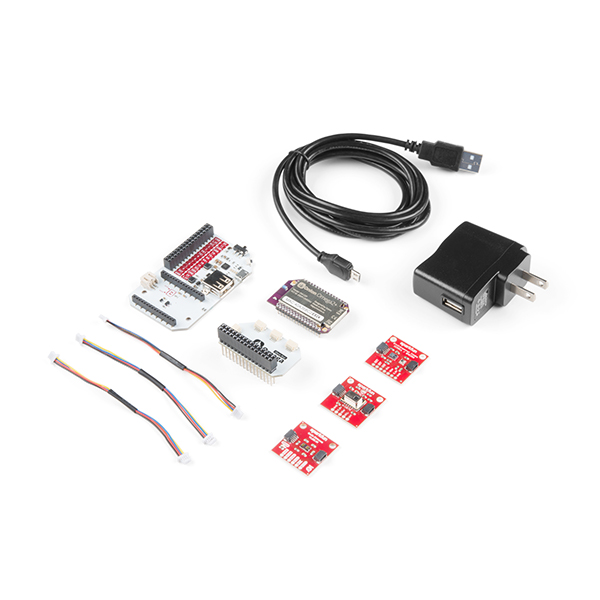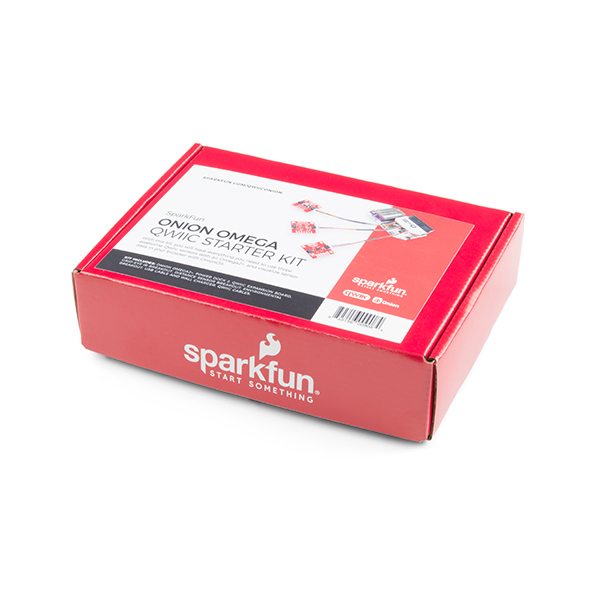SparkFun Qwiic Starter Kit for Onion Omega
When the minds at SparkFun and Onion get together we can make something truly awesome! The SparkFun Qwiic Starter Kit for Onion Omega is a blending of two different ecosystems that, when combined, provide you with an easy way to incorporate I2C sensors and breakouts in your next IoT project in the easiest way possible. Onion has even developed a web-based, graphical user interface for the Omega2 family called OnionOS, that allows you to interact with your Omega in a more visual way than the command-line. Using OnionOS, you will be able to visualize the sensor data from Qwiic boards and sensors straight from your browser!
Each Qwiic Starter Kit for Onion Omega includes an Onion Omega2+ IoT Computer, a Power Dock 2, a Qwiic Expansion Board, three different Qwiic sensors, and all the cables and power accessories needed to hooked up and started. Utilizing the VL53L1X Distance Sensor Breakout, AMG8833 Grid-EYE breakout, and the CCS811/BME280 Environmental Combo Breakout you will have all the capabilities to set up your own little sensor station powered by your Onion Omega.
The Onion Omega parts we carry are separated into three different categories: Mainboard, Dock and Expansion Board. With the parts in this kit you will be able to plug the Omega2+ Board into the Expansion Dock and add any of the included Expansion Boards to your project!
The SparkFun Qwiic Connect System is an ecosystem of I2C sensors, actuators, shields and cables that make prototyping faster and less prone to error. All Qwiic-enabled boards use a common 1mm pitch, 4-pin JST connector. This reduces the amount of required PCB space, and polarized connections mean you can’t hook it up wrong.
- 1x Onion Omega2+ IoT Computer
- 1x Power Dock 2 for Onion Omega
- 1x Qwiic Expansion Board for Onion Omega
- 1x SparkFun Distance Sensor Breakout - 4 Meter, VL53L1X (Qwiic)
- 1x SparkFun Grid-EYE Infrared Array Breakout - AMG8833 (Qwiic)
- 1x SparkFun Environmental Combo Breakout - CCS811/BME280 (Qwiic)
- 3x Qwiic Cable - 100mm
- 1x USB micro-B Cable - 6 Foot
- 1x USB Wall Charger - 5V, 1A
SparkFun Qwiic Starter Kit for Onion Omega Product Help and Resources
Core Skill: Programming
If a board needs code or communicates somehow, you're going to need to know how to program or interface with it. The programming skill is all about communication and code.
Skill Level: Competent - The toolchain for programming is a bit more complex and will examples may not be explicitly provided for you. You will be required to have a fundamental knowledge of programming and be required to provide your own code. You may need to modify existing libraries or code to work with your specific hardware. Sensor and hardware interfaces will be SPI or I2C.
See all skill levels
Core Skill: Electrical Prototyping
If it requires power, you need to know how much, what all the pins do, and how to hook it up. You may need to reference datasheets, schematics, and know the ins and outs of electronics.
Skill Level: Rookie - You may be required to know a bit more about the component, such as orientation, or how to hook it up, in addition to power requirements. You will need to understand polarized components.
See all skill levels
Comments
Looking for answers to technical questions?
We welcome your comments and suggestions below. However, if you are looking for solutions to technical questions please see our Technical Assistance page.
Customer Reviews
No reviews yet.


